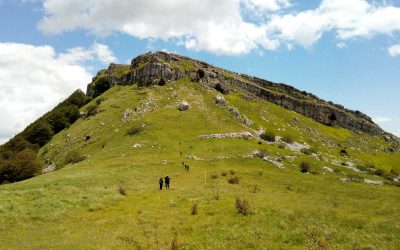| Itinerary | WAY OF THE RURAL CHURCHES - Itinerary 3: Belmonte del Sannio - Agnone |
|---|---|
| Region | |
| Start point | |
| Difficulty | |
| Lenght | |
| Walking time | |
| Height difference | |
| Maximum quota |
Course description
Close to the regional boundary line with the Abruzzo, this stage of the Camino takes us to one of the many small valleys where the tributaries of the Torrent Sente. All around us small forests, cultivated fields along gentle slopes, country farmsteads and a lot of silence. Interpodal roads seem to rest in this stillness, and the views do not frame any disturbing elements for our eyes. The trail cannot be considered easy but neither can it be considered difficult; it has small sections with steep inclines and requires crossing thin streams while balancing on outcropping stones. The background is mostly asphalt along forgotten lanes. After losing your bearings in the panorama among small valleys and high rocky mountains such as Mount Rocca l’Abate (1312m asl), we magically find ourselves at the gates of Agnone, which welcomes us with its long, wide tree-lined avenue.
Useful information
Equipment and practical advice
EQUIPMENT
To optimize your equipment, carefully read information about the route to be taken and the weather and climate forecast. This could be a list of basic equipment:
backpack suitable for real needs – At least 1L of water (2 in warm months/hot drink in winter) – Hiking map – guide – sunglasses – multifunctional penknife – head flashlight – smartphone battery charger – powerbank – camera – insect repellent – first aid kit – rain jacket – airtight bag for valuables and clothing to keep dry in case of rain – bag for trash – anti inflammatory ointment – personal medication.
Bring some light and nutritious food such as dried fruits, chocolate bars, candy, honey (energy snack). Pack your lunch in advance or be sure to pass through a town in case you need supplies. Bring trekking poles that assist in pushing uphill and help with stability on rough trails. The presence of streams and wooded trails makes some trails impassable and very muddy in heavy rains. High, waterproof hiking shoes are essential here, along with good quality (breathable) socks, which should never be underestimated! Your clothing should not lack: Windbreaker/waterproof jacket; Hat; Gloves for low temperatures.
TIPS & BEHAVIOR
Although it may seem superfluous, we recall the need to behave properly and respectfully toward others and the environment, each person making his or her own contribution by bringing back with them what would harm the environment. The path can be walked all year round, but of course spring and autumn offer the best weather and landscape conditions. For many high stretches, periods of large winter snowfall should be avoided, and in the hottest summer period, water supply and travel time should be well calculated to move during the milder hours and stop during the hottest hours. The path is well marked with comfort flags and marker arrows.
Let’s not damage the plants, let’s remember that we walk through protected environments that need to be protected. We do not light fires. We keep dogs on a leash or harness, mandatory in protected areas. We do not abandon waste. We prevent all fire hazards. We also take into account that some trails may be challenging in bad weather conditions. We always follow the official trails and when in doubt turn back to the last marked trailhead. In Molise, free camping is prohibited in certain areas, therefore, facilities that can accommodate must be used.
CAI Classification of Routes
Italian Alpine Club classification of routes according to difficulty in hiking and cycling
EXCURSION SCOPE
T = Tourist
FEATURES
Routes on cart tracks, mule tracks or obvious paths that pose no uncertainties or problems of orientation, with modest inclines and moderate elevation changes.
SKILLS AND COMPETENCIES
Require basic hiking knowledge and physical fitness for walking.
EQUIPMENT
Appropriate clothing and footwear are still required.
E = Hiking
FEATURES
Routes that represent the majority of hiking routes, thus among the most varied in terms of natural environments. They take place on mule tracks, trails and sometimes tracks; on different terrain by geomorphological and vegetation context (e.g., pastures, undergrowth, debris, scree). They are generally marked and may have steep sections. Easy, unexposed rock passages can be encountered that require the use of hands for balance. Any exposed spots are usually protected. They can cross flat or shallowly sloping areas on residual snow.
SKILLS AND COMPETENCIES
They require sense of direction and hiking experience and adequate training.
EQUIPMENT
Suitable equipment with special regard to footwear is required.
EE= Experienced hikers
FEATURES
Nearly always marked routes that require ability to move along trails and tracks over impervious and/or treacherous terrain (steep and/or slippery slopes of grass, rocks or stony debris), often unstable and uneven. They may have exposed sections, traverses, ledges or rocky sections with slight technical difficulties and/or equipped, while via ferratas proper are excluded. They are developed on medium to steep slopes. Crossing sections on snow may be necessary, while all glacier routes are excluded.
SKILLS AND COMPETENCIES
Need excellent hiking experience, orienteering skills, knowledge of the characteristics of the mountain environment, sure-footedness and absence of vertigo, evaluative and decision-making skills as well as adequate physical fitness.
EQUIPMENT
Require appropriate equipment and gear for the planned itinerary.
EEA = Experienced hikers with equipment
A ferrata is defined as a route whose sections on rock are specially equipped with metal structures: cables, chains, ladders, pegs and stirrups, which facilitate and enable its progression. They provide for the use of personal protective equipment certified according to current regulations (harness, via ferrata kit and helmet) and adequate technical preparation. They are marked at the start by special signs and meet precise construction and regulatory criteria.
Points of interest
Church of San Rocco
The first settlement of the
Church of San Rocco
of Belmonte del Sannio would date back to the 17th century. Rebuilt in 1848, the small church has what was the original village cemetery behind it. The saint invoked for protection from the plague and Our Lady of the Assumption are celebrated here on August 15.
The church was reopened for worship in 2013, and on this occasion the restored painting of Our Lady of Belmonte, now kept in the parish church of St. Savior, was presented here.
The story of this cloth, donated by the faithful of the Apulian town of San Paolo di Civitate to the Belmontese faithful in 1994, sheds light on the bond created over the centuries through Transhumance between the two towns, which are now twinned. Tommaso Lemme, a distinguished Belmontese citizen, physician and writer belonging to one of the most prominent families in the town, recounts in his book ‘Il Campanile – Memorie Abruzzesi’ written in the early 20th century, the legend of the finding of the painting of the so-called ‘Madonna of Belmonte. Hidden by transhumant shepherds from Abruzzi presumably in 600 AD to save the image from iconoclastic fury, the picture would remain buried until 1800, when it was found by a farmer from San Paolo di Civitate. The chapel dedicated precisely to Our Lady of Belmonte was then built on the site of the find. For nearly 30 years, the faithful have been visiting the twin municipality sharing the same devotion.
Fun fact: A plaque on the left side of the altar marks the burial place of the young archpriest and patriot Don Giandomenico Lemme, who was poisoned for political reasons in the second half of the 19th century.
3D Map
The linked App is not related to the website, but provides additional convenience in using the presented content. Its use is voluntary. If the app is not yet installed on your device, you will be redirected to the corresponding App Store.
Belmonte del Sannio – Agnone
(km 6.63)
Itinerary 3
Departure: Belmonte del Sannio
Arrival: Agnone
Distance: 6.63 kilometers
Walking time: 1h 40′
Difficulty: Hiking
Difficulty: +300 -350
73% asphalt – 27% dirt roads
Cyclability: Yes – presence of steep slope sections
Recommended Period: Spring, summer, fall
GPX files: Download
![]()
![]()
![]()
![]()
Frame or click the QR code and open the Web App
It should be noted that the routes may include sections where vehicular traffic is concurrent.
Photographs
Other Itineraries
![]() I1: Civitanova del Sannio – Poggio Sannita
I1: Civitanova del Sannio – Poggio Sannita![]() I2:Poggio Sannita – Belmonte del Sannio
I2:Poggio Sannita – Belmonte del Sannio![]() I3: Belmonte del Sannio – Agnone
I3: Belmonte del Sannio – Agnone![]() I4: Agnone – Capracotta
I4: Agnone – Capracotta![]() I5: Capracotta – Pescopennataro
I5: Capracotta – Pescopennataro![]() I6: Pescopennataro – Sant’Angelo del Pesco
I6: Pescopennataro – Sant’Angelo del Pesco![]() I7: Sant’Angelo del Pesco – Castel del Giudice
I7: Sant’Angelo del Pesco – Castel del Giudice![]() I8: Castel del Giudice – Capracotta
I8: Castel del Giudice – Capracotta![]() I9: Poggio Sannita – Castelverrino
I9: Poggio Sannita – Castelverrino![]() I10: Castelverrino – Agnone
I10: Castelverrino – Agnone
Highlights
Discovering the Way of the Country Churches at Easter and Easter Monday
In Italy there are many itineraries for walk and live " slow ", the Cammino delle Chiese Campestri is among them. Walking outdoors, following a specific path, immersing ourselves in a place with body, mind and heart propels us into a new dimension in which time "seems...
The long bridge of Immaculate Conception in Upper Molise, among culture, traditions and nature
The December 9, 2023 , the 'Ndocciata, Italy's most evocative fire-related event, will be celebrated in Agnone, a town in the highlands of Molise. Protagonists are the 'Ndocce, torches nearly three meters high, which will give life to a sparkling river of fire that...
Nature trails in Upper Molise, presented the project of the Countryside Churches Trail
From the partnership between 9 municipalities of Upper Molise, Agnone, Belmonte del Sannio, Capracotta, Castel del Giudice, Castelverrino, Civitanova del Sannio, Pescopennataro, Poggio Sannatita, and Sant'Angelo del Pesco, the project of sustainable tourism which...


The “Walk of the Country Churches” is an outdoor trail of about 90 kilometers connecting 9 historical centers e 15 small churches scattered throughout the territory of Agnone, Belmonte del Sannio , Capracotta, Castel del Giudice, Castelverrino, Civitanova del Sannio, Pescopennataro, Poggio Sannita e Sant’Angelo del Pesco.
© The Way Of The Country Churches | Project | Credit | Privacy Policy | Cookie Policy | Contact
INITIATIVE FUNDED BY THE FEASR – European Agricultural Fund for Rural Development – PSR Molise Region 2014 – 2020












